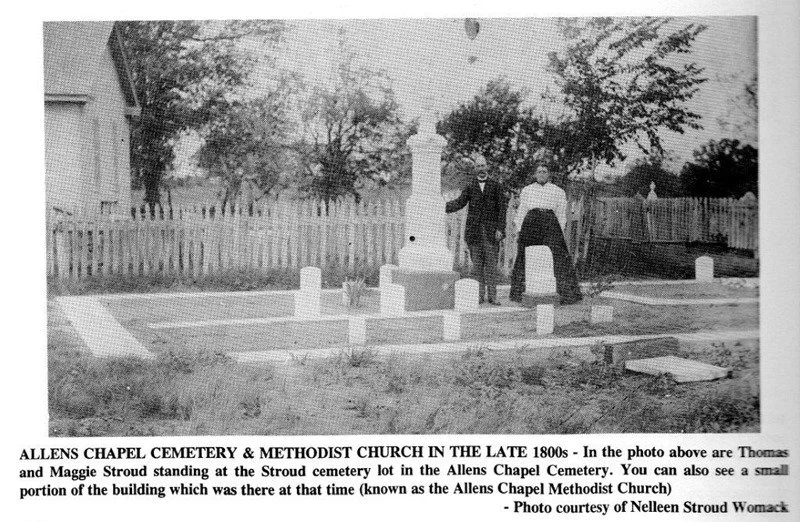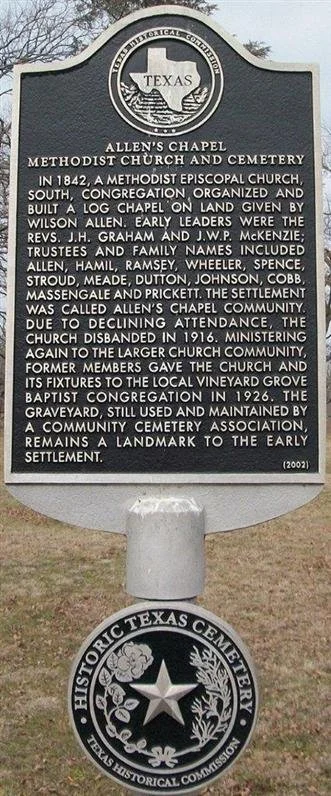Allen's Chapel Methodist Church & Cemetery
Marker Text:
In 1842, a Methodist Episcopal Church, South, congregation organized and built a log chapel on land given by Wilson Allen. Early leaders were the Revs. J. H. Graham and J. W. P. McKenzie; trustees and family names included Allen, Hamil, Ramsey, Wheeler, Spence, Stroud, Meade, Dutton, John, Cobb, Massengale and Prickett. The settlement was called Allen's Chapel Community. Due to declining attendance, the church disbanded in 1916. Ministering again to the larger church community, former members gave the church and its fixtures to the local Vineyard Grove Baptist congregation in 1926. The graveyard, still used and maintained by a community cemetery association, remains a landmark to the early settlement.
Directions:
From Honey Grove, drive 2 miles west on US 82. Turn north for 4 miles on FM 1396 to intersection of FM 1396 and CR 2750. Turn east on CR 2750 and travel 1 mile to cemetery.
More information on the Allens Chapel Cemetery is on the Fannin County GenWeb site and on the Honey Grove Preservation League’s website.
History of the Allens Chapel Methodist Church & Cemetery
As submitted to Texas Historical Commission
In 1842, a Methodist Church was organized and a small log structure was built on land donated by Wilson Bruce Allen. Deeds as recorded stipulated that four acres be given to the Methodist Episcopal Church South for use as determined by its designated trustees. The church building was located in the eastern part of Fannin County, some 15 miles north and 70 degrees east of Bonham, and seven miles northwest of Honey Grove, Texas. Today this site can be fund one mile east of the intersection of FM #1396 and County Road #2750. The church's establishment was one of the earliest in the area, and, as a result, the settlement took the name Allens Chapel Community.
The date of Wilson Allen's migration from his native South Carolina to Texas is uncertain; census records, headright patents and some family lore place his arrival in 1836, though other church stories mark his arrival earlier. Regardless, he arrived in the newly-created Fannin County shortly after Texas gained its independence, and received Fannin County Second Class Land Certificates allowing him to acquire considerable acreage in the area. His mother and brothers also claimed large amounts of the surrounding land for the Allens, and they and the other nearby settlers soon began holding religious services in their homes.
As interest in these services grew - and with the influence of Methodist missionaries (or "circuit riders"), who had been spreading the word in the Red River area from as early as 1813 - the need for a central meeting place became clear. Thus did the Allens Chapel Church open its doors under the guidance of the Reverend James Graham, a dedicated Methodist preacher and educator of the time.
Before becoming a part of the Republic of Texas, settlers in the region of the of the Red River from the Great Bend west were a legislative part of what was Miller County, Arkansas, and thus fell under the purview of the Arkansas Methodist Conference. However, by 1844, with the Texas boundary lines firmly established and allegiances to Arkansas no longer felt by the settlers, the Methodist churches of northeast Texas were shifted to the East Texas Conference and assigned to districts as applicable.
During this time, Methodism was moving rapidly across Texas. Newly established churches in this district received valuable assistance from various leaders relocating from other states. This was a unique historical period; a new Republic established, followed by Statehood. The previous Mexican laws prohibiting Protestant congregations were no longer applicable in Texas, and freedom of religion proved quite a draw for those living to the north and east of the new country.
A chart was prepared about 1852 listing several Methodist "preaching places" in this district for delegated preachers to hold services. It gave specific details, such as location, church leaders, lodging accommodations, etc. At this time Allens Chapel was listed as having 55 white and four black members.
Since Allens Chapel was the first Methodist church established in this part of the county, numerous people from Honey Grove and the surrounding areas attended. The original log structure was replaced (date unknown) by a larger frame building. Written sources describe it as a well-constructed building with excellent fixtures that accommodated large gatherings consistent with its membership and the great interest attracted by their revivals.
Though the first two deeds, struck in 1850 and 1877, made no specific mention of such grounds being used for burial purposes, a cemetery arose next to the church building. In 1892, W. B. Allen officially conveyed the one acre to the church for just such a use. Common practice at that time was for churches to provide space for their parishioners to bury their dead near the church, as opposed to the use of family plots. Thus, authorized trustees of the church approved the use of outlying church grounds as a cemetery. Existing gravestones reveal the first interment - one Margaret B. Massengale - to have taken place in 1856, although earlier burials may have occurred with no markers now in existence.
As the year passed and the other area communities grew, many members of the Allens Chapel Church relocated. As the population of Fannin county peaked at 51,793 in 1900, more Methodist congregations were being created. Honey Grove, for example, formed their own church, and for this and various other reasons Allens Chapel saw attendance decline and interest wane, to the point that, in 1916, the church activities were disbanded.
In 1926, the remaining authorities of the church determined that, for the benefit of the community, the building and its fixtures would be donated to the Vineyard Grove Church, a Baptist organization, for its use as needed to construct its new building. Thus the practice of ministering to others, regardless of their religious affiliation, existed from the founding days of the Allens Chapel Methodist Church through its closing and final act.
The Allens Chapel Cemetery continued to be used through the years by the members of the community, though it fell into disrepair. In 1962 a most important problem was solved via the organization of the Allens Chapel-Vineyard Grove Cemetery Association - a natural merger, since so many buried in each cemetery were kinfolk. Bylaws were established and officers were elected with the goal in mind of performing needed improvements and establishing the means for the upkeep of two community cemeteries. A fence was constructed around the Allens Chapel Cemetery, gates were hung, a sign posted and a gravel road entrance laid. Through the years, other changes in the property and by-laws have been made. The picturesque 100 year old oak at the entrance still stands, however.
Though its original affiliation was with the Methodist church, the Allens Chapel Cemetery is now a community cemetery, with people of all faiths interred there. Today, the Cemetery Association maintains the burial grounds via permanent improvements and regular maintenance. Additionally, the Association is active in community-wide activities, including the recent completion of a Community Center which fully accommodates functions that contribute to the welfare of a progressive rural community - a community that traces its beginnings to a primitive log church established in 1842.

